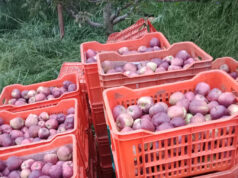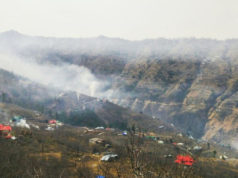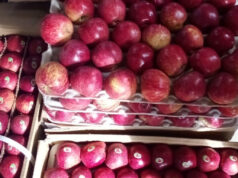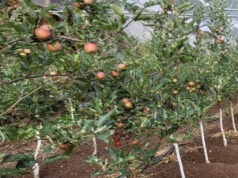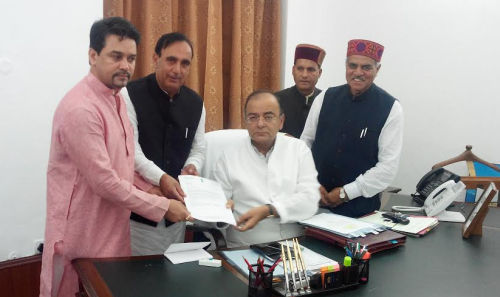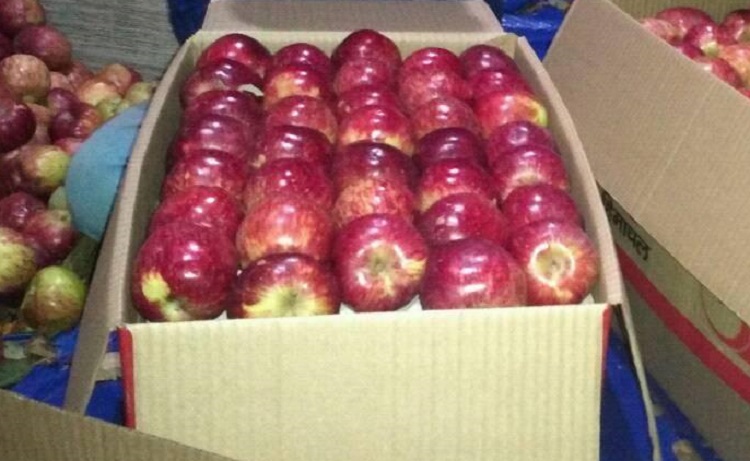By Ankur Jamwal and Mohit Sharma
Horticulture is a vital contributor to Himachal Pradesh’s economy, with apples accounting for approximately 80% of its output. Though not native to the region, apples have become deeply woven into the state’s social and economic fabric, earning Himachal Pradesh the identity of the “Apple State” of India. However, this legacy is now under threat from climate change. Yields have become increasingly erratic, and in many areas, they are declining. Farmers in the lower parts of Kullu district have already shifted to alternative crops. This situation demands a deeper exploration of the challenges faced by apple growers, whose livelihood is critical to the state’s overall economic health.
Apple cultivation depends on a certain number of cold days—known as chilling hours—to produce healthy flowers and fruit. Scientific evidence suggests that climate change is reducing winter chilling hours in traditional apple-growing zones, negatively impacting productivity. Near-future climate projections (within 15 years), such as those analysed by Azim Premji University using multiple climate models, place Himachal Pradesh among the states most at risk from rising average maximum temperatures and increased precipitation. While the entire state is expected to experience warming, apple-growing regions like Chamba, Kullu, Kinnaur, Lahaul-Spiti, and Shimla are projected to be worst affected, with temperature increases of 1.4 to 1.5°C above the 1960 baseline.
Though this rise may seem modest, it represents an average—many areas will experience significantly higher spikes. Winters are expected to become shorter and warmer, leading to reduced snowfall and quicker melting. This disrupts the crucial chilling period needed for apples, causing delayed flowering, poor fruit setting, early ripening, reduced fruit size, and lower quality—issues that result in poor market rates. Apples also lose their attractive red coloration when summer temperatures exceed 24°C, further lowering market value.
Moreover, apples are highly sensitive to drought, unseasonal rains, and strong winds during blossom. Projections from the Azim Premji dataset show a 3–4% increase in annual precipitation, with most of it falling as rain rather than snow. This rain is expected to become more intense and concentrated, occurring over shorter periods, and interspersed with long dry spells. Devastating monsoon floods in recent years and unusually heavy rainfall in February this year are examples of this pattern, which is expected to worsen in frequency and severity.
This year, snowfall in the state was minimal and occurred late—in February—when temperatures are relatively warmer than in December and January. As a result, snow melted quickly, offering little benefit to soil moisture. Snowmelt occurring gradually over winter helps recharge the soil and sustain apple orchards. In contrast, heavy rainfall in hilly areas results in runoff, causing erosion, landslides, and flash floods, all of which harm productivity and damage the supply chain by destroying roads and infrastructure.
Despite an expansion in apple cultivation area, yields have declined. Between 2017 and 2022, the area under cultivation increased by 5.4% compared to 2011–2016, but yields dropped by 14%, according to the Department of Horticulture, Government of Himachal Pradesh. Warmer conditions have pushed apple farming to higher elevations. The Lahaul-Spiti district, once considered too cold for apples, now has extensive orchards. But official data shows that yields in these new areas are highly variable and trending downward.
The media coverage of apple growers’ grievances highlights how climate variability has turned farming into a gamble. Nearly 2.5 lakh families depend on income from apple orchards, and any drop in production ripples across the economy, affecting downstream businesses that rely on the orchardists’ cash flow.
To safeguard apple cultivation against climate risks, Himachal Pradesh needs a comprehensive, multi-pronged strategy. Research and development must focus on developing indigenous rootstocks and climate-resilient varieties that require fewer chilling hours. Reducing dependence on imported planting material and focusing on locally adapted cultivars will enhance the sector’s long-term adaptability. As domestic apple growers also face increasing competition from cheaper imports—especially from the USA and Iran—creating strong, market-ready Indian varieties is critical to sustaining their livelihoods.
In light of the changing climate, the current apple farming model needs significant revision. Some reforms, like high-density plantation, are already underway in the state. New water-efficient farming techniques, such as the Rajasthan model of apple cultivation in arid conditions, could be explored to diversify Himachal’s cultivation methods. Presently, apple orchards heavily depend on chemical inputs, which are degrading soil health and weakening tree resilience. Comprehensive soil rejuvenation efforts are needed to restore microbial diversity and strengthen disease resistance in apple trees.
Combining sustainable agricultural practices with modern marketing strategies is essential. For instance, high-density plantations can be linked with contract farming models to ensure farmers have assured markets. Additionally, establishing real-time market intelligence systems can help farmers make informed decisions. These systems can track market trends, demand, pricing, and weather forecasts—enabling growers to decide the best times to harvest and sell. They also promote collaborative selling by connecting small-scale farmers who can pool their produce and negotiate better prices collectively.
To further support these efforts, government subsidies for sustainable practices and insurance schemes for climate-related losses must be expanded. However, building resilience also requires long-term investment in education. Revamping agricultural education in Himachal Pradesh is critical to preparing future generations. Universities must be equipped to train students in interpreting climate data and transforming it into actionable insights for farmers. The state should provide sufficient funding for institutions to develop advanced computational tools and modelling capabilities. Integration of improved weather forecasting tools into agricultural curricula should also be explored.
The 6th Dean’s Committee Draft Report on agricultural education rightly emphasises the need for new-age courses in machine learning, environmental studies, and disaster management. However, these should not be token additions to academic transcripts—they must offer practical, skill-based training so that graduates entering state departments can effectively contribute to climate resilience strategies.
Climate change poses a profound threat to apple farming in Himachal Pradesh, endangering both the state’s economy and its cherished identity as the “Apple State” of India. Rising temperatures, unpredictable weather, and declining yields are pushing growers into uncertainty and out of orchards. To combat this crisis, the state must act with urgency and vision—developing resilient apple varieties, adopting sustainable practices, modernising market infrastructure, and equipping the next generation through climate-conscious education. Only a collaborative, forward-thinking approach can ensure that Himachal’s apple legacy continues to thrive beneath an increasingly unpredictable sky.
Ankur Jamwal is faculty at Azim Premji University and Mohit Sharma is a faculty at the Dr. Rajendra Prasad Central Agricultural University, Pusa – Bihar.
The views and opinions expressed in this article are those of the author and do not necessarily reflect the views or the positions of the organisation they represent.


